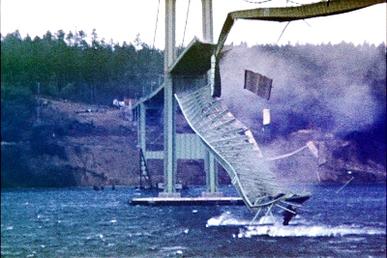The 1940 collapse of the Tacoma Narrows Bridge in the US is one of the most iconic examples of catastrophic bridge failure, and an event that changed bridge engineering history.

Dubbed Galloping Gertie, it was the third largest suspension bridge in the world, behind only the George Washington and Golden Gate bridges.
As workmen finished the sleek bridge's floor system in May, engineers and others noticed the deck's vertical wave motions, or ‘bounce’. Engineers installed hydraulic jacks at the towers to act as shock absorbers, but to no avail.
Professor F Bert Farquharson from the University of Washington was contacted to conduct wind tunnel studies, in an effort to find a solution.
Farquharson later said, "We knew from the night of the day the bridge opened that something was wrong. On that night the bridge began to gallop." Temporary tie-down cables were installed, which seemed to make some improvement.
On November 7 1940, only four months after it was opened, strong winds blew through the Narrows from the southwest. They blasted Gertie broadside, directly against the deck's solid plate girder.
The state of the art, $6 million bridge began to violently bounce and twist, with several waves up to 1.5 metres high. As the sounds of the bridge’s writhing filled the air, the undulations became more and more violent; twice, the roadway dropped 18 metres, faster than gravity, then bounced upward, finally settling into a 10 metre-deep sag. Eventually, it collapsed into the water in a mangled heap.
For many years resonant frequency was believed to be the cause of the catastrophic collapse. However, it’s now known that torsional flutter was to blame.
In
an article for Forbes, astrophysicist and author Ethan Siegel explains it this way:
“As the wind passed over the bridge on November 7, a stronger, more sustained wind than it had ever experienced before, causing vortices to form as the steady wind passed over the bridge. In small doses, this wouldn't pose much of a problem, but take a look at the effects of these vortices on a structure in the video below.“Over time, they cause a aerodynamic phenomenon known as ‘flutter’, where the extremities in the direction of the wind get an extra rocking motion to them. This causes the outer portions to move perpendicular to the wind direction, but out-of-phase from the overall up-and-down motion of the bridge. This phenomenon of flutter has been known to be disastrous for aircraft, but it was never seen in a bridge before. At least, not to this extent.“When the flutter effect began, one of the steel suspension cables supporting the bridge snapped, removing the last major obstacle to this fluttering motion. That was when the additional undulations, where the two sides of the bridge rocked back-and-forth in harmony with one another, began in earnest. With the sustained, strong winds, the continued vortices, and no ability to dissipate those forces, the bridge's rocking continued unabated, and even intensified. The last humans on the bridge, the photographers, fled the scene.“But it wasn't resonance that brought the bridge down, but rather the self-induced rocking! Without an ability to dissipate its energy, it just kept twisting back-and-forth, and as the twisting continued, it continued to take damage, just as twisting a solid object back-and-forth will weaken it, eventually leading to it breaking. It didn't take any fancy resonance to bring the bridge down, just a lack of foresight of all the effects that would be at play, cheap construction techniques, and a failure to calculate all the relevant forces." Take a look at the frankly terrifying footage.
If you’d like to read more about the bridge collapse, Motherboard published
an excellent article on the subject, and the Washington State Department of Transport has a
fascinating history of the event.